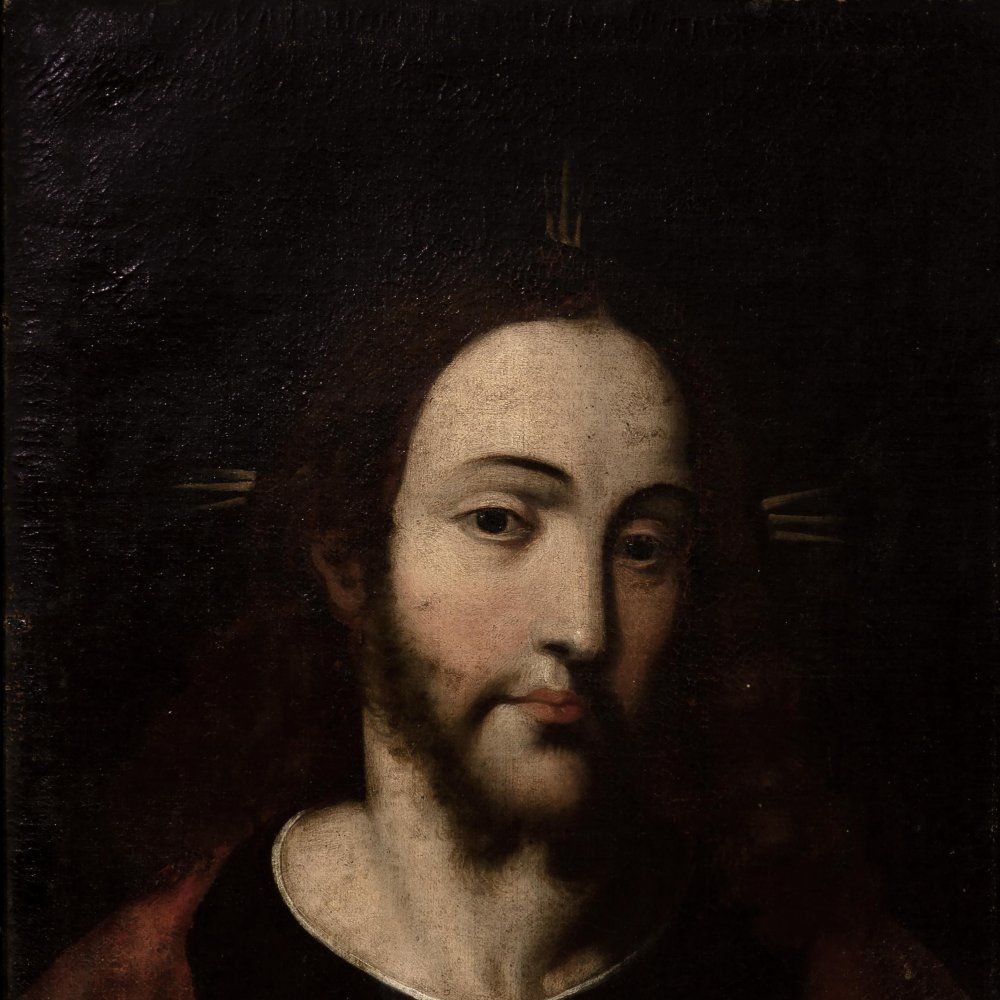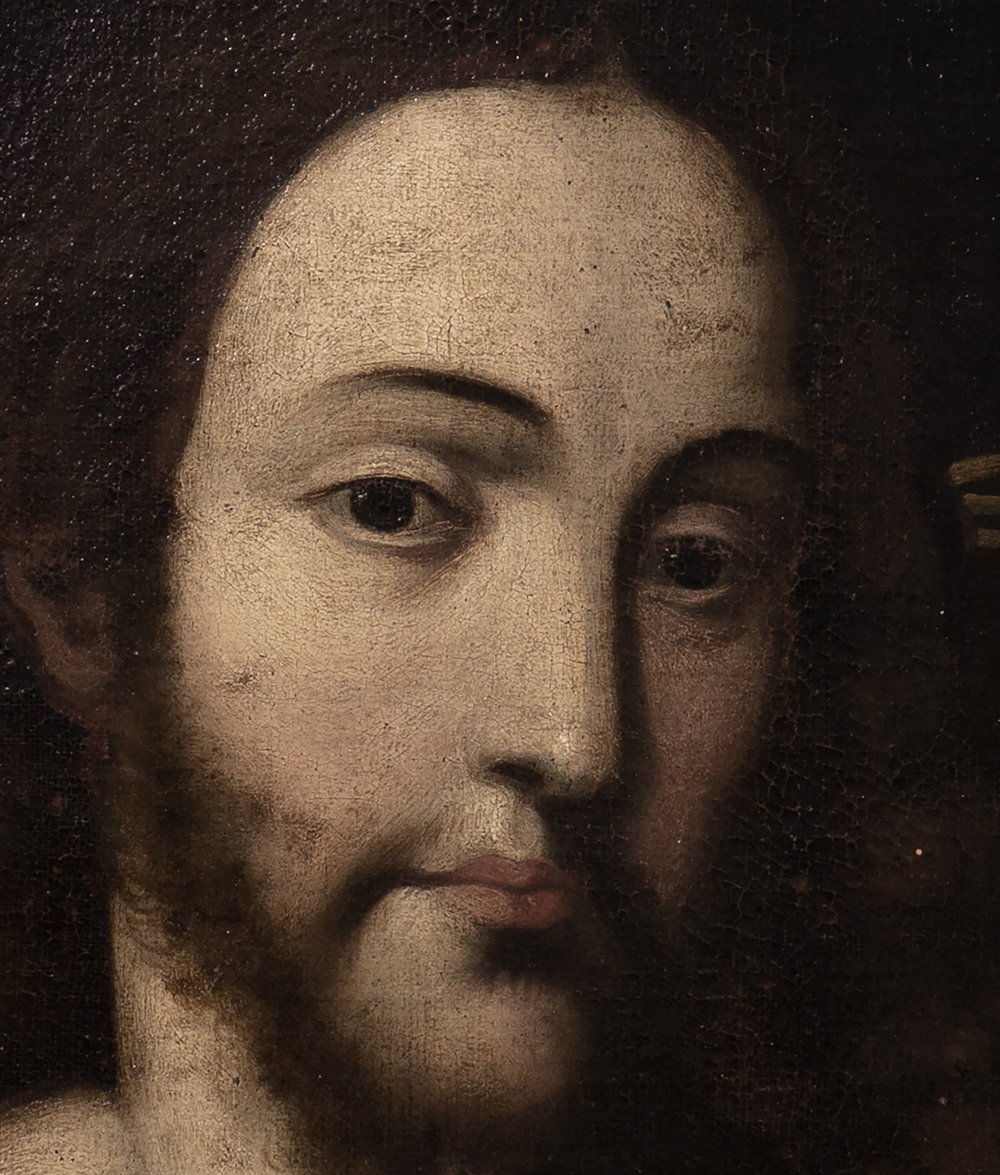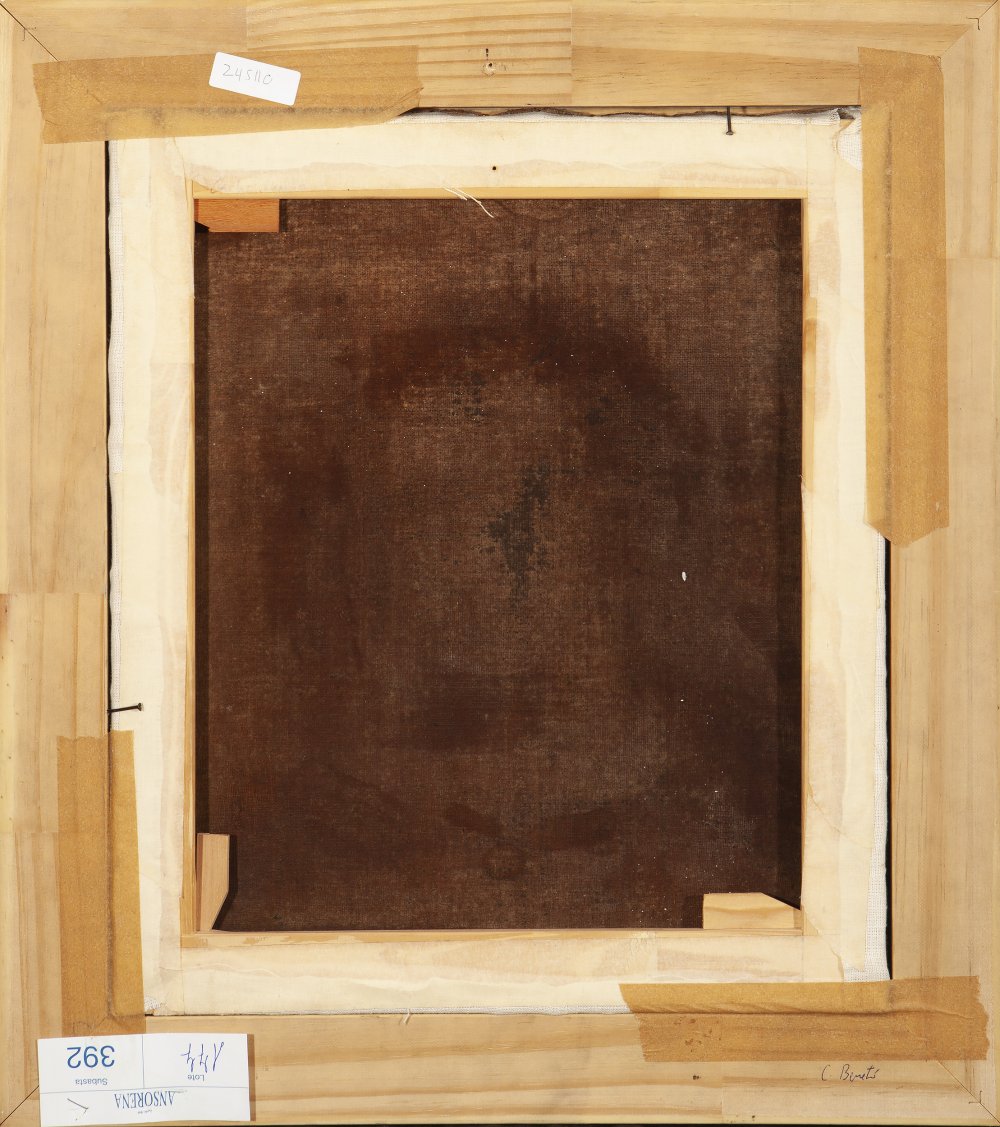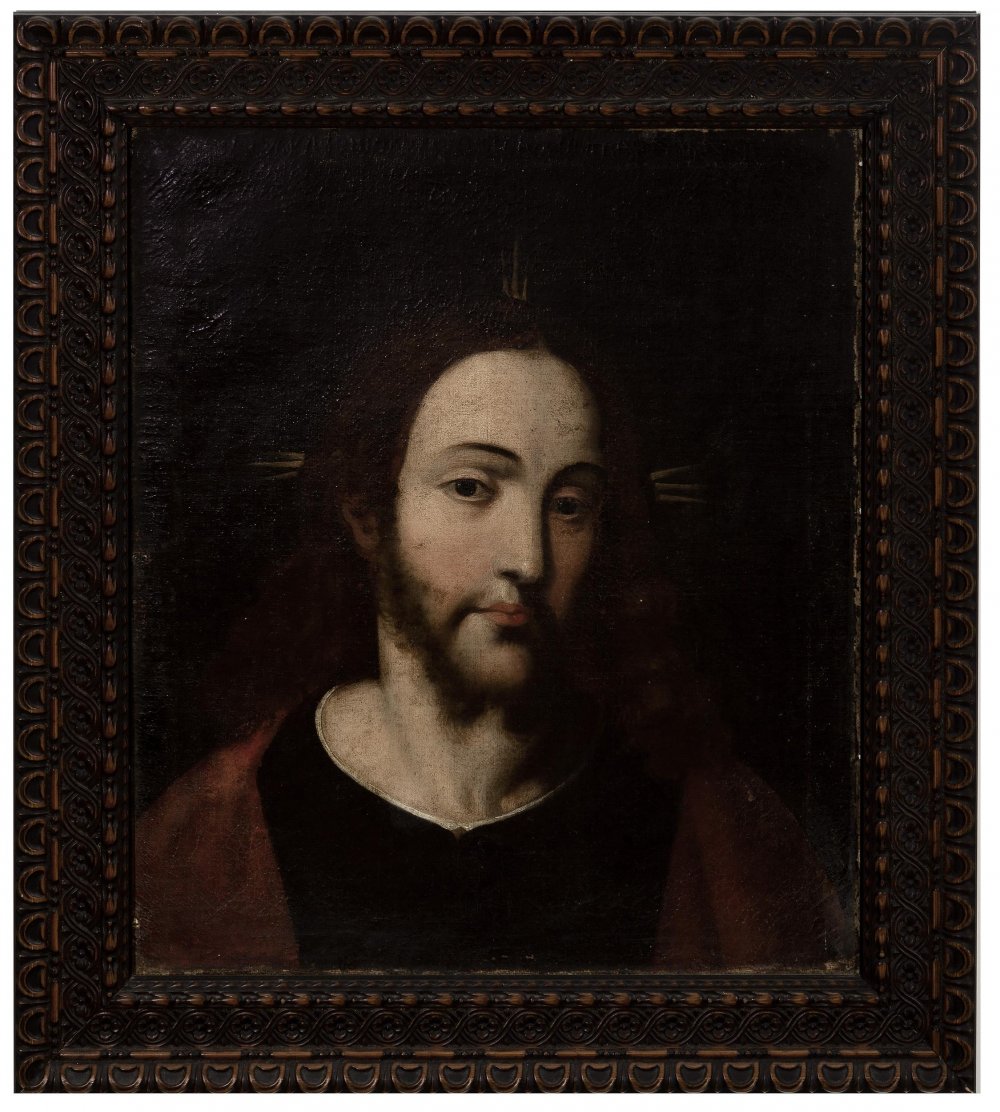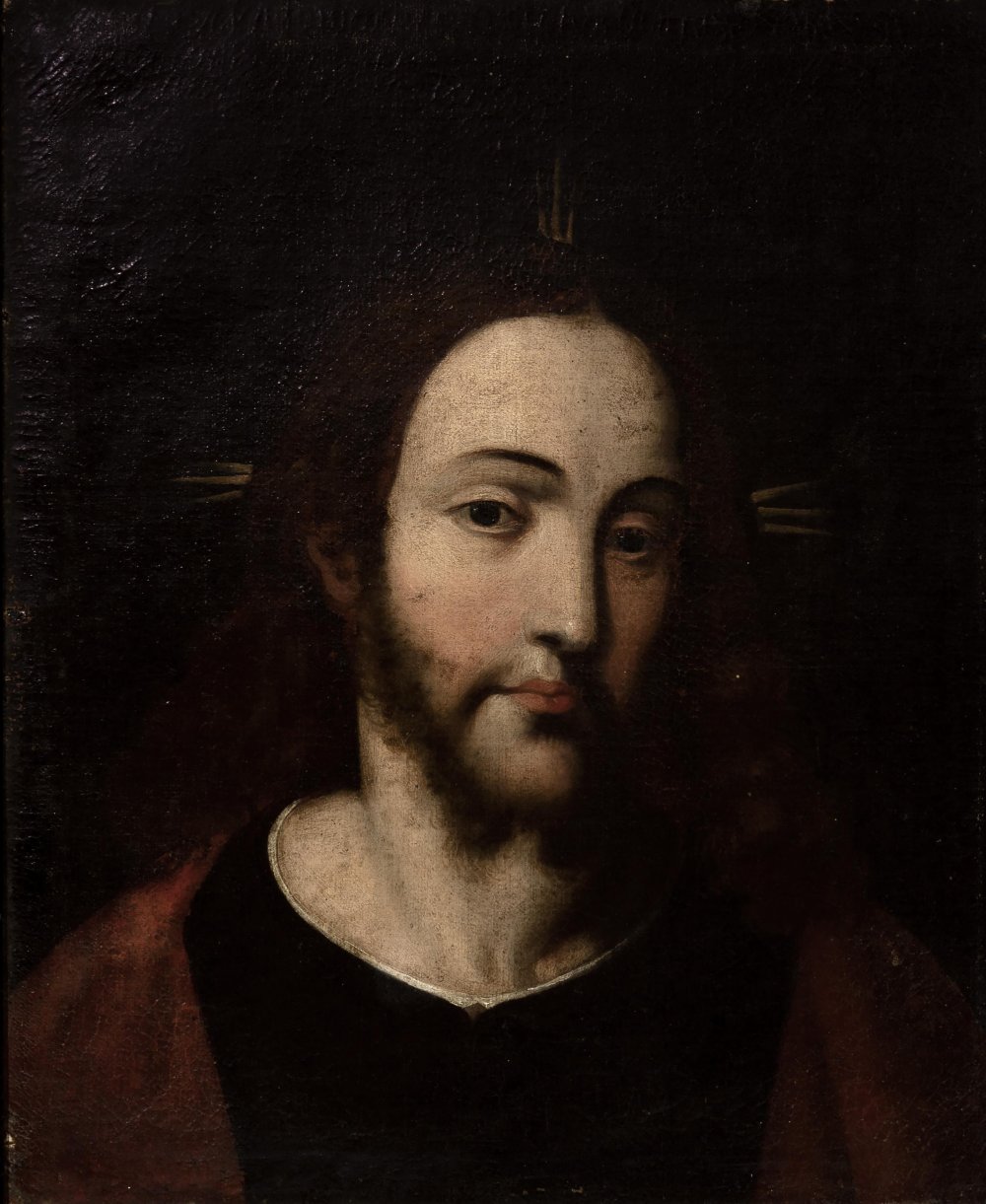51
Circle of FRANCISCO RIBALTA (Solsona, Lérida, 1565-Valencia, 1628).First half of the 17th century."
1/5
Description
Circle of FRANCISCO RIBALTA (Solsona, Lérida, 1565-Valencia, 1628).
First half of the 17th century.
"The Saviour".
Oil on canvas.
It has a small hole on the left side, not very noticeable. It presents lateral bands added.
Measurements: 51 x 44,5 cm; 65 x 58 cm (frame).
In the present image, we are shown a portrait of Christ as Saviour, a typical representation that embraces the Christological concept of Jesus Christ as saviour. As far as can be seen, he is dressed in the ornamental clothing, a blue tunic and a red cloak belonging to his usual representation. It is a triumphant Christ who has conquered death and saved the world; his attitude is serene and almost smiling, with no traces of suffering left.
Originally Catalan, Ribalta began his training at El Escorial, within the Mannerism that dominated court painting at the time. After beginning his career in Madrid he moved to Valencia in 1599, probably encouraged by the patronage of the patriarch Archbishop Juan de Ribera. There he produced his first known works, the altarpieces for the church of Algemesí, which denote a style somewhere between the mannerism of the Escorial style and naturalism. During these early years of the 17th century he carried out several commissions for the archbishop, whose death in 1611 marked a certain stylistic shift in Ribalta's work. His language took on an intimate and profound slant, very much in keeping with the more pious mood of the Counter-Reformation, inspired by the solemn gravity of certain models by Sebastiano del Piombo that he knew in Valencia itself. Ribalta was able to combine these influences with a naturalistic, direct language for which he was particularly gifted. His chromaticism also became more restrained and sober, and his figures became less gesticulated and more expressive. From the second decade of the century his pupil Vicente Castelló and his son Juan Ribalta worked with him, forming a solid and prolific artistic team in which it is sometimes difficult to distinguish their individualities. Around 1618 Ribalta fell ill, and this was the beginning of his last and most mature period of his production. He painted fewer works, but his style became more intense and emotive, moving towards a profound naturalism of moving force, as can be seen in his great painting "Embrace of Saint Francis to the Crucified", painted for the Capuchins in Valencia around 1622. Six years later Francisco Ribalta died, and a few months later his son Juan also died, leaving behind guidelines in Valencian painting that would last for a long time, conditioning the development of the Baroque style. In fact, Ribalta was, together with Velázquez and Ribera, one of the main founders of the naturalistic language in Spain.
Works by Francisco Ribalta can be seen in the Prado Museum, the National Gallery in London, the Fine Arts Museum in Valencia, the Hermitage in St. Petersburg, the Louvre, the National Art Museum of Catalonia, the Chi-Mei in Taiwan and the J. Paul Getty Museum in Los Angeles, among other leading art galleries around the world.
First half of the 17th century.
"The Saviour".
Oil on canvas.
It has a small hole on the left side, not very noticeable. It presents lateral bands added.
Measurements: 51 x 44,5 cm; 65 x 58 cm (frame).
In the present image, we are shown a portrait of Christ as Saviour, a typical representation that embraces the Christological concept of Jesus Christ as saviour. As far as can be seen, he is dressed in the ornamental clothing, a blue tunic and a red cloak belonging to his usual representation. It is a triumphant Christ who has conquered death and saved the world; his attitude is serene and almost smiling, with no traces of suffering left.
Originally Catalan, Ribalta began his training at El Escorial, within the Mannerism that dominated court painting at the time. After beginning his career in Madrid he moved to Valencia in 1599, probably encouraged by the patronage of the patriarch Archbishop Juan de Ribera. There he produced his first known works, the altarpieces for the church of Algemesí, which denote a style somewhere between the mannerism of the Escorial style and naturalism. During these early years of the 17th century he carried out several commissions for the archbishop, whose death in 1611 marked a certain stylistic shift in Ribalta's work. His language took on an intimate and profound slant, very much in keeping with the more pious mood of the Counter-Reformation, inspired by the solemn gravity of certain models by Sebastiano del Piombo that he knew in Valencia itself. Ribalta was able to combine these influences with a naturalistic, direct language for which he was particularly gifted. His chromaticism also became more restrained and sober, and his figures became less gesticulated and more expressive. From the second decade of the century his pupil Vicente Castelló and his son Juan Ribalta worked with him, forming a solid and prolific artistic team in which it is sometimes difficult to distinguish their individualities. Around 1618 Ribalta fell ill, and this was the beginning of his last and most mature period of his production. He painted fewer works, but his style became more intense and emotive, moving towards a profound naturalism of moving force, as can be seen in his great painting "Embrace of Saint Francis to the Crucified", painted for the Capuchins in Valencia around 1622. Six years later Francisco Ribalta died, and a few months later his son Juan also died, leaving behind guidelines in Valencian painting that would last for a long time, conditioning the development of the Baroque style. In fact, Ribalta was, together with Velázquez and Ribera, one of the main founders of the naturalistic language in Spain.
Works by Francisco Ribalta can be seen in the Prado Museum, the National Gallery in London, the Fine Arts Museum in Valencia, the Hermitage in St. Petersburg, the Louvre, the National Art Museum of Catalonia, the Chi-Mei in Taiwan and the J. Paul Getty Museum in Los Angeles, among other leading art galleries around the world.
Auction Details
Shipping
T&Cs & Important Info
Ask seller a question
Circle of FRANCISCO RIBALTA (Solsona, Lérida, 1565-Valencia, 1628).
First half of the 17th century.
"The Saviour".
Oil on canvas.
It has a small hole on the left side, not very noticeable. It presents lateral bands added.
Measurements: 51 x 44,5 cm; 65 x 58 cm (frame).
In the present image, we are shown a portrait of Christ as Saviour, a typical representation that embraces the Christological concept of Jesus Christ as saviour. As far as can be seen, he is dressed in the ornamental clothing, a blue tunic and a red cloak belonging to his usual representation. It is a triumphant Christ who has conquered death and saved the world; his attitude is serene and almost smiling, with no traces of suffering left.
Originally Catalan, Ribalta began his training at El Escorial, within the Mannerism that dominated court painting at the time. After beginning his career in Madrid he moved to Valencia in 1599, probably encouraged by the patronage of the patriarch Archbishop Juan de Ribera. There he produced his first known works, the altarpieces for the church of Algemesí, which denote a style somewhere between the mannerism of the Escorial style and naturalism. During these early years of the 17th century he carried out several commissions for the archbishop, whose death in 1611 marked a certain stylistic shift in Ribalta's work. His language took on an intimate and profound slant, very much in keeping with the more pious mood of the Counter-Reformation, inspired by the solemn gravity of certain models by Sebastiano del Piombo that he knew in Valencia itself. Ribalta was able to combine these influences with a naturalistic, direct language for which he was particularly gifted. His chromaticism also became more restrained and sober, and his figures became less gesticulated and more expressive. From the second decade of the century his pupil Vicente Castelló and his son Juan Ribalta worked with him, forming a solid and prolific artistic team in which it is sometimes difficult to distinguish their individualities. Around 1618 Ribalta fell ill, and this was the beginning of his last and most mature period of his production. He painted fewer works, but his style became more intense and emotive, moving towards a profound naturalism of moving force, as can be seen in his great painting "Embrace of Saint Francis to the Crucified", painted for the Capuchins in Valencia around 1622. Six years later Francisco Ribalta died, and a few months later his son Juan also died, leaving behind guidelines in Valencian painting that would last for a long time, conditioning the development of the Baroque style. In fact, Ribalta was, together with Velázquez and Ribera, one of the main founders of the naturalistic language in Spain.
Works by Francisco Ribalta can be seen in the Prado Museum, the National Gallery in London, the Fine Arts Museum in Valencia, the Hermitage in St. Petersburg, the Louvre, the National Art Museum of Catalonia, the Chi-Mei in Taiwan and the J. Paul Getty Museum in Los Angeles, among other leading art galleries around the world.
First half of the 17th century.
"The Saviour".
Oil on canvas.
It has a small hole on the left side, not very noticeable. It presents lateral bands added.
Measurements: 51 x 44,5 cm; 65 x 58 cm (frame).
In the present image, we are shown a portrait of Christ as Saviour, a typical representation that embraces the Christological concept of Jesus Christ as saviour. As far as can be seen, he is dressed in the ornamental clothing, a blue tunic and a red cloak belonging to his usual representation. It is a triumphant Christ who has conquered death and saved the world; his attitude is serene and almost smiling, with no traces of suffering left.
Originally Catalan, Ribalta began his training at El Escorial, within the Mannerism that dominated court painting at the time. After beginning his career in Madrid he moved to Valencia in 1599, probably encouraged by the patronage of the patriarch Archbishop Juan de Ribera. There he produced his first known works, the altarpieces for the church of Algemesí, which denote a style somewhere between the mannerism of the Escorial style and naturalism. During these early years of the 17th century he carried out several commissions for the archbishop, whose death in 1611 marked a certain stylistic shift in Ribalta's work. His language took on an intimate and profound slant, very much in keeping with the more pious mood of the Counter-Reformation, inspired by the solemn gravity of certain models by Sebastiano del Piombo that he knew in Valencia itself. Ribalta was able to combine these influences with a naturalistic, direct language for which he was particularly gifted. His chromaticism also became more restrained and sober, and his figures became less gesticulated and more expressive. From the second decade of the century his pupil Vicente Castelló and his son Juan Ribalta worked with him, forming a solid and prolific artistic team in which it is sometimes difficult to distinguish their individualities. Around 1618 Ribalta fell ill, and this was the beginning of his last and most mature period of his production. He painted fewer works, but his style became more intense and emotive, moving towards a profound naturalism of moving force, as can be seen in his great painting "Embrace of Saint Francis to the Crucified", painted for the Capuchins in Valencia around 1622. Six years later Francisco Ribalta died, and a few months later his son Juan also died, leaving behind guidelines in Valencian painting that would last for a long time, conditioning the development of the Baroque style. In fact, Ribalta was, together with Velázquez and Ribera, one of the main founders of the naturalistic language in Spain.
Works by Francisco Ribalta can be seen in the Prado Museum, the National Gallery in London, the Fine Arts Museum in Valencia, the Hermitage in St. Petersburg, the Louvre, the National Art Museum of Catalonia, the Chi-Mei in Taiwan and the J. Paul Getty Museum in Los Angeles, among other leading art galleries around the world.
29th December - Old Masters
Sale Date(s)
Venue Address
Aragón 346, Barcelona
Calle Velázquez 7, Madrid
Carrer de Cirilo Amorós 55, Valencia
Barcelona
08009
Spain
General delivery information available from the auctioneer
Setdart offers Worldwide shipping
PICK UP IN ROOM: You can come and pick up your lots in our offices (Barcelona, Madrid or Valencia). At the moment of the withdrawal, you will be able to accept the current conditions of the lot by means of a document that you will sign.
YOU CAN SEND ANOTHER PERSON TO PICK UP: This person must present a signed authorization that you can find in our web page by accessing from BUY AT SETDART- LOGISTICS-DOWNLOAD AUTHORIZATION DOCUMENT. You can also send an e-mail with the requested data in AUTHORIZATION DOCUMENT to admin@setdart.com
Important Information
25% buyer´s premium
21% buyer´s premium at www.setdart.com











